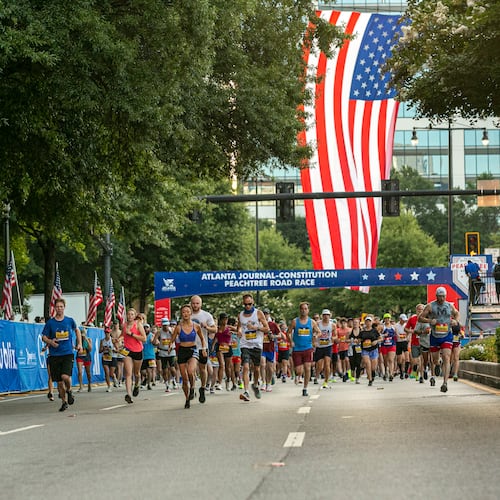On July 4, 1776, at Independence Hall in Philadelphia, the United States of America was born.
The Second Continental Congress officially approved the Declaration of Independence, which declared America’s freedom from British rule and founded a new country, grounded on the principles of liberty, equality? and self-governance.
We celebrate July 4 as Independence Day. But how well do you know the history of the Declaration of Independence — and Independence Day?
Try this eight-question quiz prepared by the Bill of Rights Institute for the AJC. Scroll to find out if you answered correctly.
Question 1: Thomas Jefferson is widely credited as the author of the Declaration of Independence. But he was actually part of a committee responsible for drafting the document. That group was known as the Committee of ___?
- A. Liberty
- B. Justice
- C. Five
- D. Seven
Question 2: Of the 56 individuals who signed the Declaration of Independence, how many would go on to become U.S. presidents?
- A. 5
- B. 4
- C. 3
- D. 2
Question 3: On July 4, 1776, representatives from 12 of the 13 Colonies voted to approve the Declaration of Independence. Which colony abstained?
- A. Massachusetts
- B. Pennsylvania
- C. Rhode Island
- D. New York
Question 4: Which of these American founders did not sign the Declaration of Independence?
- A. James Madison
- B. Samuel Adams
- C. John Hancock
- D. Samuel Chase
Question 5: What was the southernmost colony to have representatives sign the Declaration of Independence?
- A. Virginia
- B. Georgia
- C. South Carolina
- D. Florida
Question 6: In November 1863, Abraham Lincoln referenced the Declaration of Independence when he stated our forefathers had created, “a new nation, conceived in liberty, and dedicated to the proposition that all men are created equal.” Where did Lincoln give that speech?
- A. Washington, D.C.
- B. Springfield, Illinois
- C. Gettysburg, Pennsylvania
- D. Baltimore, Maryland
Question 7: Who was serving as U.S. president when Independence Day became recognized as a federal holiday in 1870?
- A. Ulysses S. Grant
- B. Rutherford B. Hayes
- C. James Garfield
- D. Andrew Johnson
Question 8: The abolition, women’s suffrage and civil rights movements frequently referred to the rights expressed in the Declaration of Independence and U.S. Constitution and called on America to ensure they were granted to all people. This famous civil rights leader called these rights a “promissory note to which every American was to fall heir.”
- A. Frederick Douglass
- B. Thurgood Marshall
- C. Martin Luther King Jr.
- D. Rosa Parks
Credit: Bill of Rights Institute
Credit: Bill of Rights Institute
Check your answers to the questions on the quiz
- Question 1 Answer: C — The Committee of Five was responsible for drafting the Declaration of Independence, and included Jefferson, John Adams, Benjamin Franklin, Robert Livingston and Roger Sherman. Jefferson was the primary author but received feedback and edits from the other committee members.
- Question 2 Answer: D — Two of the original signers, John Adams and Thomas Jefferson, would be elected president of the United States. Several other signers served as governors in their home states and in other state and federal leadership positions.
- Question 3 Answer: D — New York originally abstained from approving the Declaration of Independence because its delegates had not yet received instructions on how to vote. Days later, New York officially gave approval, and some of the most pivotal battles of the Revolutionary War took place in New York.
- Question 4 Answer: A — James Madison was 25 years old when the Declaration of Independence was approved, and while he was active in Virginia state politics at the time, he was not a Virginia delegate to the Second Continental Congress.
- Question 5 answer: B — Georgia was one of America’s original 13 Colonies and was the southernmost colony. Georgians Button Gwinnett, Lyman Hall and George Walton all signed the Declaration of Independence.
- Question 6 answer: C — Abraham Lincoln delivered his famous Gettysburg Address in Gettysburg, Pennsylvania, in November 1863, four months after the Battle of Gettysburg. The Gettysburg Address was less than 300 words but is considered one of the most important reflections on America’s founding principles and the ongoing work of ensuring those principles endure.
- Question 7 answer: A — Although Independence Day had long been informally celebrated by Americans, Congress passed legislation in 1870 that officially made it a federal holiday. The president at the time was Ulysses S. Grant.
- Question 8 answer: C — The Rev. Martin Luther King Jr.’s famous 1963 “I Have a Dream” speech in Washington referred to America’s founding documents as a promissory note. King said he and his followers had come to the nation’s capital to “cash a check” for the unalienable rights of life, liberty and the pursuit of happiness.
Kirk Higgins is vice president of content at the Bill of Rights Institute, a nonpartisan, nonprofit organization that teaches civics and history.
About the Author
Keep Reading
The Latest
Featured




